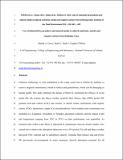| dc.contributor.author | M.A.. Grace, M.G. Healy, E.Clifford | |
| dc.date.accessioned | 2015-04-18T11:57:05Z | |
| dc.date.available | 2015-04-18T11:57:05Z | |
| dc.date.issued | 2015 | |
| dc.identifier.citation | M.A.. Grace, M.G. Healy, E.Clifford (2015) 'Use of industrial by-products and natural media to adsorb nutrients, metals and organic carbon from drinking water'. Science Of The Total Environment, 518 - 519 :491-497. | en_US |
| dc.identifier.uri | http://dx.doi.org/10.1016/j.scitotenv.2015.02.075 | |
| dc.identifier.uri | http://hdl.handle.net/10379/4937 | |
| dc.description.abstract | Filtration technology is well established in the water sector but is limited by inability to remove targeted contaminants, found in surface and groundwater, which can be damaging to human health. This study optimises the design of filters by examining the efficacy of seven media (fly ash, bottom ash, Bayer residue, granular blast furnace slag (GBS), pyritic fill, granular activated carbon (GAC) and zeolite), to adsorb nitrate, ammonium, total organic carbon (TOC), aluminium, copper (Cu) and phosphorus. Each medium and contaminant was modelled to a Langmuir, Freundlich or Tempkin adsorption isotherm, and the impact of pH and temperature (ranging from 10°C to 29°C) on their performance was quantified. As retention time within water filters is important in contaminant removal, kinetic studies were carried out to observe the adsorption behaviour over a 24 h period. Fly ash and Bayer residue had good TOC, nutrient and Cu adsorption capacity. Granular blast furnace slag and pyritic fill, previously un-investigated in water treatment, showed adsorption potential for all contaminants. In general, pH or temperature adjustment was not necessary to achieve effective adsorption. Kinetic studies showed that at least 60% of adsorption had occurred after 8 h for all media. These media show potential for use in a multifunctional water treatment unit for the targeted treatment of specific contaminants. | en_US |
| dc.language.iso | en | en_US |
| dc.relation.ispartof | Science Of The Total Environment | en |
| dc.rights | Attribution-NonCommercial-NoDerivs 3.0 Ireland | |
| dc.rights.uri | https://creativecommons.org/licenses/by-nc-nd/3.0/ie/ | |
| dc.subject | adsorption isotherms | en_US |
| dc.subject | nutrients | en_US |
| dc.subject | metals | en_US |
| dc.subject | organic pollutants | en_US |
| dc.subject | environmental quality | en_US |
| dc.title | Use of industrial by-products and natural media to adsorb nutrients, metals and organic carbon from drinking water | en_US |
| dc.type | Article | en_US |
| dc.date.updated | 2015-03-16T09:53:30Z | |
| dc.description.peer-reviewed | peer-reviewed | |
| dc.contributor.funder | |~|Environmental Protection Agency|~| | |
| dc.internal.rssid | 8492036 | |
| dc.local.contact | Mark Healy, Room Eng-1038, Civil Engineering, Col Of Engineering & Informatics, Nui Galway. 5364 Email: mark.healy@nuigalway.ie | |
| dc.local.copyrightchecked | Yes | |
| dc.local.version | ACCEPTED | |
| nui.item.downloads | 606 | |


